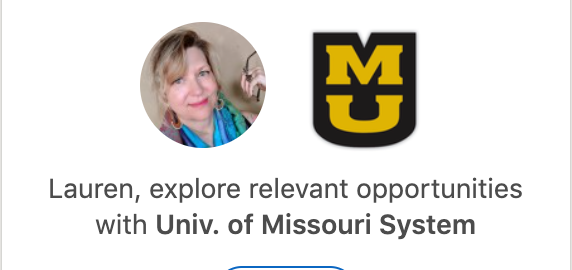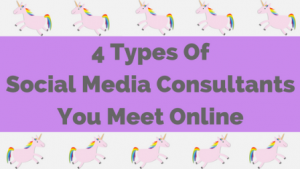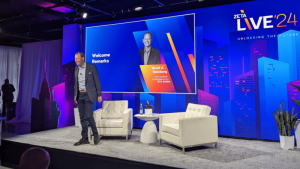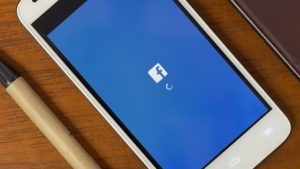You’re probably aware that LinkedIn is one of the best places to reach the business market. The network has almost 740 million members and is the most trusted of all the social media sites.
Maybe you already use LinkedIn for recruiting talent. But how else could your business benefit from reaching that audience? If businesspeople are part of your target market, you could use LinkedIn ads to generate traffic to your site and make sales.
Table of Contents
- What is LinkedIn advertising?
- When and why to use LinkedIn ads
- How much do LinkedIn ads cost?
- How to create LinkedIn ads
- LinkedIn ads best practices
- Move toward your goals
What is LinkedIn advertising?
If you don’t spend much time on LinkedIn, you might not be familiar with the ads. But if you’re logged in and visit your homepage at LinkedIn, you’ll see them in your feed.
Mixed in with posts and activity from people and companies you follow, you’ll see posts that are subtly marked as “promoted.” Those are paid LinkedIn ads in the form of sponsored posts or feed ads.

LinkedIn ads show up as “promoted” tweets, like this one from Trello.
Text and image-based ads also appear in the right rail on your screen when you access the site using a computer. Finally, ads are sometimes delivered straight to your inbox as sponsored InMail.
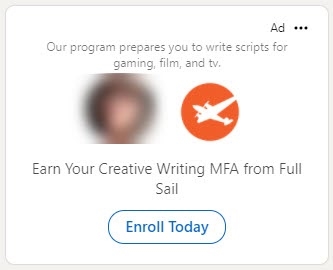
Ads like this one from Full Sail appear in the right column when accessing LinkedIn from a desktop device.
LinkedIn advertising gets your message in front of people you’ve targeted, even if you don’t share any connections. In that way, it’s a lot like Facebook or Instagram ads.
What makes the LinkedIn audience different from those of other platforms is mindset. When they’re using LinkedIn, people are thinking about their jobs or businesses.
When and why to use LinkedIn ads
If you’re promoting business-to-business (B2B) or professional services or products, this could be the time when people are most receptive to your messaging. That’s why LinkedIn ads are popular for promoting B2B and professional services and products.
Who uses LinkedIn ads?
LinkedIn ads are a good choice for:
- Financial services
- Productivity apps
- Professional training
- Workshops and seminars
- Professional courses
- Business software
- Accounting services
- Virtual Assistant services
- Marketing firms
- Postgraduate programs
- Web developers
- Consultants
- Professional services
What goals can LinkedIn ads help you reach?
If you’re marketing to businesses or to consumers who are professionals, LinkedIn ads can help you reach goals like:
- Increasing brand awareness
- Getting views for your promo video
- Gaining traffic to your best web content
- Establishing your authority
- Signing up new leads
- Making sales
When are LinkedIn ads a good option?
Since people are in a business mindset while they’re using the platform, these ads are a good choice when you want to draw people into your business messaging, whether that means watching a short promotional video, checking out a link, or signing up for a free trial.
How much do LinkedIn ads cost?
LinkedIn ads are priced by auction, so there isn’t a set cost. However, you are in control of your bids and your overall spending.
You place a bid when you launch your campaign, and so do other advertisers who want to reach the same target audience. The more desirable your target audience is, the higher your bid needs to be for your ad to be seen. If you’ve ever bought Google ads, this process will be familiar to you.
You’ll also specify an objective when you set up your campaign, and that will determine which events you pay for. For example, if you set up a campaign with a website visit objective, you’ll only pay when someone clicks the link in your ad.
You’ll choose one of seven objectives when you set up a campaign:
- Brand Awareness: Get the word out about your product, services, or organization.
- Website Visits: Pay only when someone visits your website or landing page.
- Engagement: Pay when someone likes, comments, shares, clicks to your landing page, or follows your LinkedIn page.
- Video Views: Pay only when people watch your video ad.
- Lead Generation: Capture leads with a LinkedIn form.
- Website Conversions: Capture leads on your website.
- Job Applicants: Drive applicants to your job openings.
- Talent Leads: This objective is specifically for recruiting ads.
On average, LinkedIn ads are one of the best bargains on the internet. The average cost of LinkedIn ads is $ 5.26 per click, $ 6.59 per 1000 impressions, and $ 0.80 per send.
You can control your overall spending by setting a daily budget for your ads. The system will try to buy ads for you at the bidding price you’ve set until your maximum budget has been reached.
The minimum budget is $ 10 a day, which means that for a very affordable rate, you can start testing some ads to see how they work for you. It’s a good idea to start with the minimum budget until you’ve tried a few different ad formats to see what works well for your business.
How to create LinkedIn ads
You can create your own LinkedIn ads or work with a campaign manager to help you create them. Here are the steps to create your own ads.
Set up Campaign Manager
The first step is to create a Campaign Manager account. From your LinkedIn homepage, just click on the “work” area and then select “Advertise.” You’ll be invited to start setting up your account.
Choose an objective
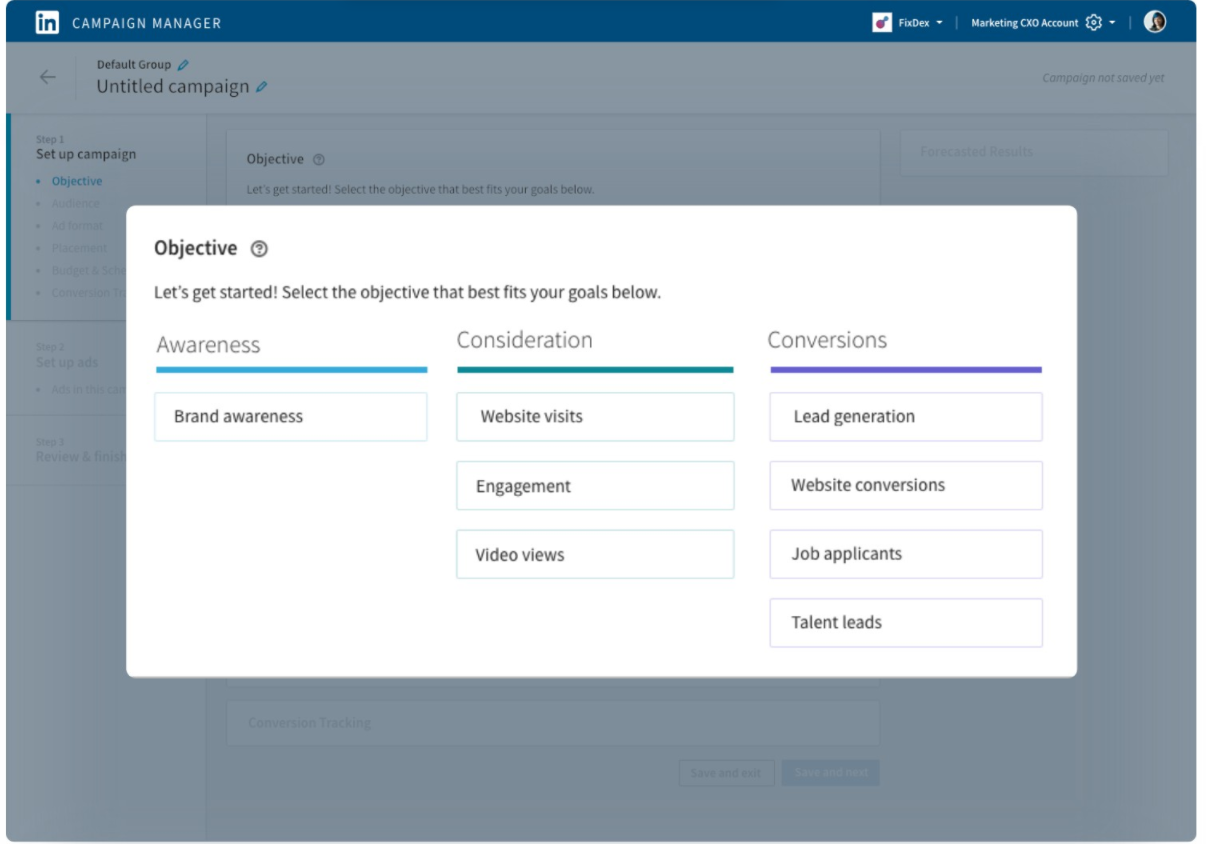
Choosing an objective will help determine both the price and the content of your ad.
What do you hope will happen as a result of your ad? For example, perhaps you’re trying to increase your name recognition in your industry, build an email list, or sign users up for a free trial of your software.
Your objective should shape everything about your ad, from the graphics and text you choose to the audience you target, so you’ll need to set this up first.
Set a target audience
There are lots of targeting options to choose from, including:
- Company size
- Company name
- Member schools
- Member interests
- Member groups
- Skills
- Job title
- Job seniority
If you don’t already have a clear picture of who your target audience is, this section may feel overwhelming.
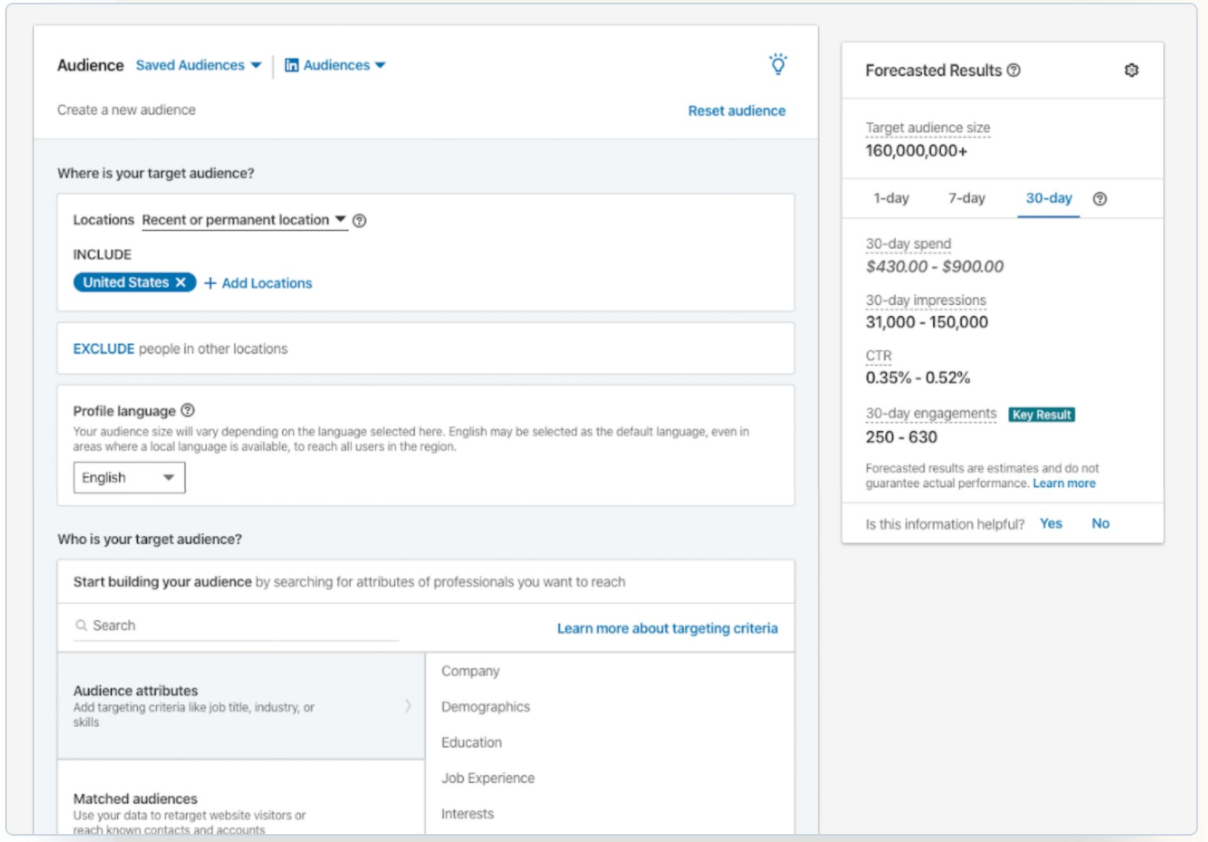
Take the questions one at a time to choose the best target audience.
But if you take the questions one at a time, you should emerge with a clear description of your target market. Watch the forecasting area on the right-hand side of the screen to see how your choices impact the size of your market and your potential click-through rates (CTR).
Once you’ve created a target audience that suits your business, save it as a template so you can reuse it when you create your next ad.
Over time, you’ll be able to test different targeting settings to find what works best for your business.
Choose your LinkedIn ad format
LinkedIn offers four ad formats, which you can mix and match to best meet your goals.
- Sponsored posts appear in users’ feeds alongside posts from their contacts. This is a great place to put interactive content like videos, links to articles, graphics, and longer messaging.
- Message ads are sponsored text messages delivered directly to your contact’s inbox.
- Dynamic ads can be tailored to different demographics. These appear in the sidebar and are especially useful for inviting new followers or promoting events or job listings.
- Text ads are the easiest and fastest to create. You can easily launch a pay-per-click (PPC) or cost-per-impression (CPM) campaign in minutes.
Set your budget
Choose one of three options for your budget:
- Cost per send (CPS) is for message ads.
- Cost per click (CPC) lets you pay only when people visit a landing page, follow your business, or register for an event.
- Cost per impression (CPM) is the best choice when you’re trying to build brand awareness or simply get your message seen.
Once you’ve chosen an option, you’ll be able to enter a bid amount, a daily budget, and the dates you want your campaign to run. Keep in mind that you can always end a campaign early if it’s not working for you.
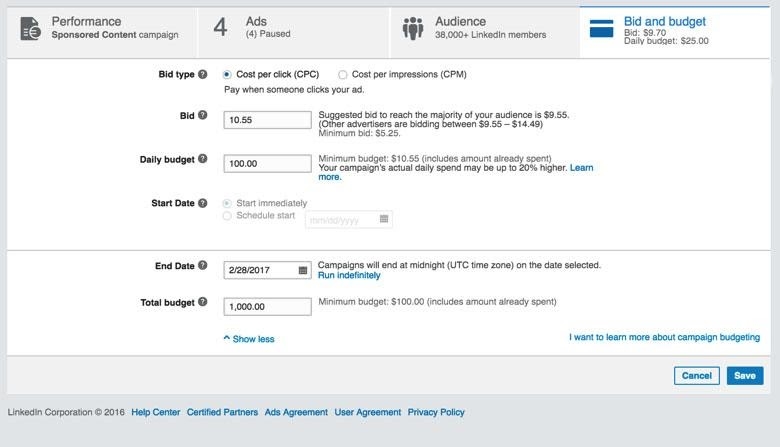
Choose your bid type and amount, but remember, you can always adjust them later.
Don’t worry if you’re not sure how much to bid. The Campaign Manager will offer you some guidance in choosing a bid amount, suggesting competitive ranges for the options you’ve chosen. You can always adjust your bid later if you don’t like the results you’re getting.
Note that there is a 20% grace amount around your daily budget, which means your campaign could cost as much as 20% extra per day.
Revise and optimize
Once your campaign is live, you’ll be able to view statistics like overall impressions, clicks, social actions, and cost.
Test out different ads, targeting, budgets, and bidding to see what works best for your business.
LinkedIn ads best practices
These tips and strategies will improve your results from LinkedIn ads.
Audience size
To optimize your target audience, LinkedIn recommends aiming for an audience size of 50,000 or more. If your audience is smaller than that, tweak your settings to expand it. For sponsored mail messages, shoot for 15,000 or more.
You can use the words “or” and “and” to broaden or narrow your audience. For instance, you might target customers who are “business owners and web developers,” which is a smaller and more specific audience than those who are “business owners or web developers.”
If you enable the Campaign Manager’s Audience Expansion feature, it will target audiences with similar attributes to what you choose.
You can also add a Matched Audience that targets your website visitors or email subscribers by simply linking to your site or uploading your mailing list.
Ideal content
Keep your content brief. In general, shorter is better.
- Videos: Less than 30 seconds (people will watch longer videos only if they’ve previously engaged with your brand)
- Headlines: Under 150 characters
- Subheads: CTRs are better if you don’t use them at all
- InMail messages: Under 500 characters is ideal; don’t go over 1,000
Use bite-sized messaging to pique interest. Cite an industry statistic, ask a question, or tease just one benefit of your service. People can discover the rest when they click on your link or sign up for your email.
Offering useful industry content is a great way to connect with LinkedIn browsers.
Focus on your customer’s point of view. Don’t tell them about your company. Talk about their needs instead. Eliminate the word “we” from your ads, and shift your messaging to use “you” a lot more.
Try to incorporate people in your images — smiling human faces making eye contact with the viewer are nearly always a good idea. For dynamic ads, saying yes to the option of including a profile picture can increase your results by 100%.
You can use images that aren’t people, too. Just make sure they are high contrast and easy to view at small sizes, like on a mobile device screen. Any text should be readable at a glance.
Sponsored posts should look as much like organic content as possible. Case studies are popular because people love to read about how others in their situation have solved problems. To run a case study ad, create a blog post about a customer who was helped by your service and link to it in a sponsored post with an enticing headline.
Message ads that will go straight to the reader’s inbox are more successful if they’re informal, brief, and as personalized as possible. At the very least, greet the reader by their first name.
Whatever type of ad you’re creating, make sure your call to action is very clear. What do you want your audience to do, and why — from their perspective — should they do it?
Insight tag
Installing a snippet of javascript called the Insight Tag on your website will allow you to track your results. The tag lets LinkedIn track visitors’ actions on your site so you can read much more detailed reports.
The insight tag will allow you to track conversions, retarget website visitors, and see other data about how visitors from your LinkedIn ads are interacting with your brand. It also lets you optimize your ads for different types of conversions — like product purchase, demo request, newsletter signup, or software trial.
Testing & changing ads
Change up your ads often to keep them fresh — but consider sending the new ads to the same target audience.
People will get more comfortable with your company as they see your messaging over time. You’ve probably experienced this as a consumer — a business that’s been in front of you regularly for months automatically feels more reliable and stable than one you’ve never heard of before.
You can take advantage of that by targeting the same audience with a series of ads. For instance, you might create five ads that each stress one of your product’s benefits. Run each ad for two weeks, and target the same audience the entire time.
Try not to run more than two ads at a time so you can easily track your results.
LinkedIn ads examples
Here are some real-world examples of LinkedIn ads, pulled from the site itself.
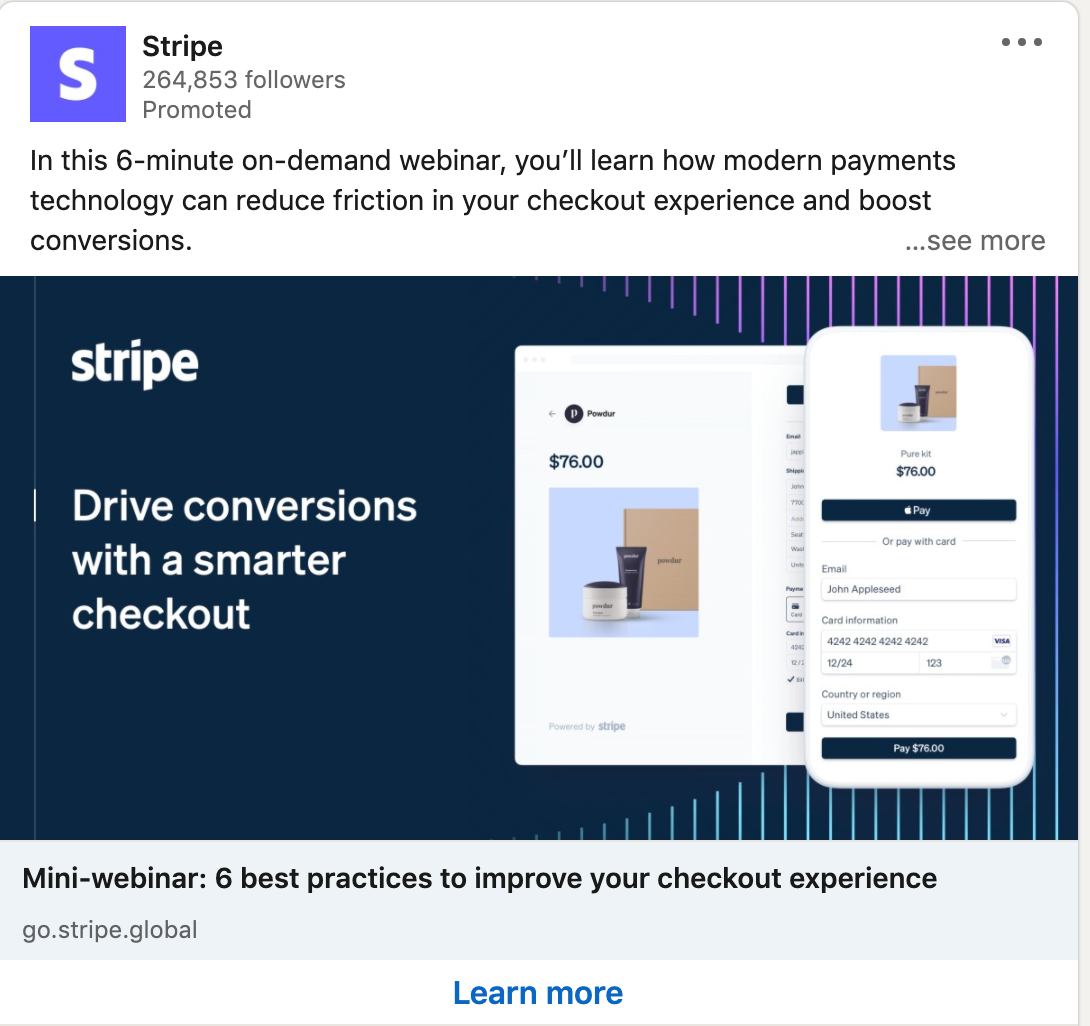
A clear, concise, focused LinkedIn ad from Stripe.
This ad is very concise and clear. It focuses on just one of Stripe’s benefits — driving conversions with a smarter checkout. The image doesn’t have a human face, but it’s simple and high contrast, and it features a text snippet that draws your eye. It’s also very clear what the ad is selling — a six-minute webinar that will teach you how to boost conversions with your checkout process.
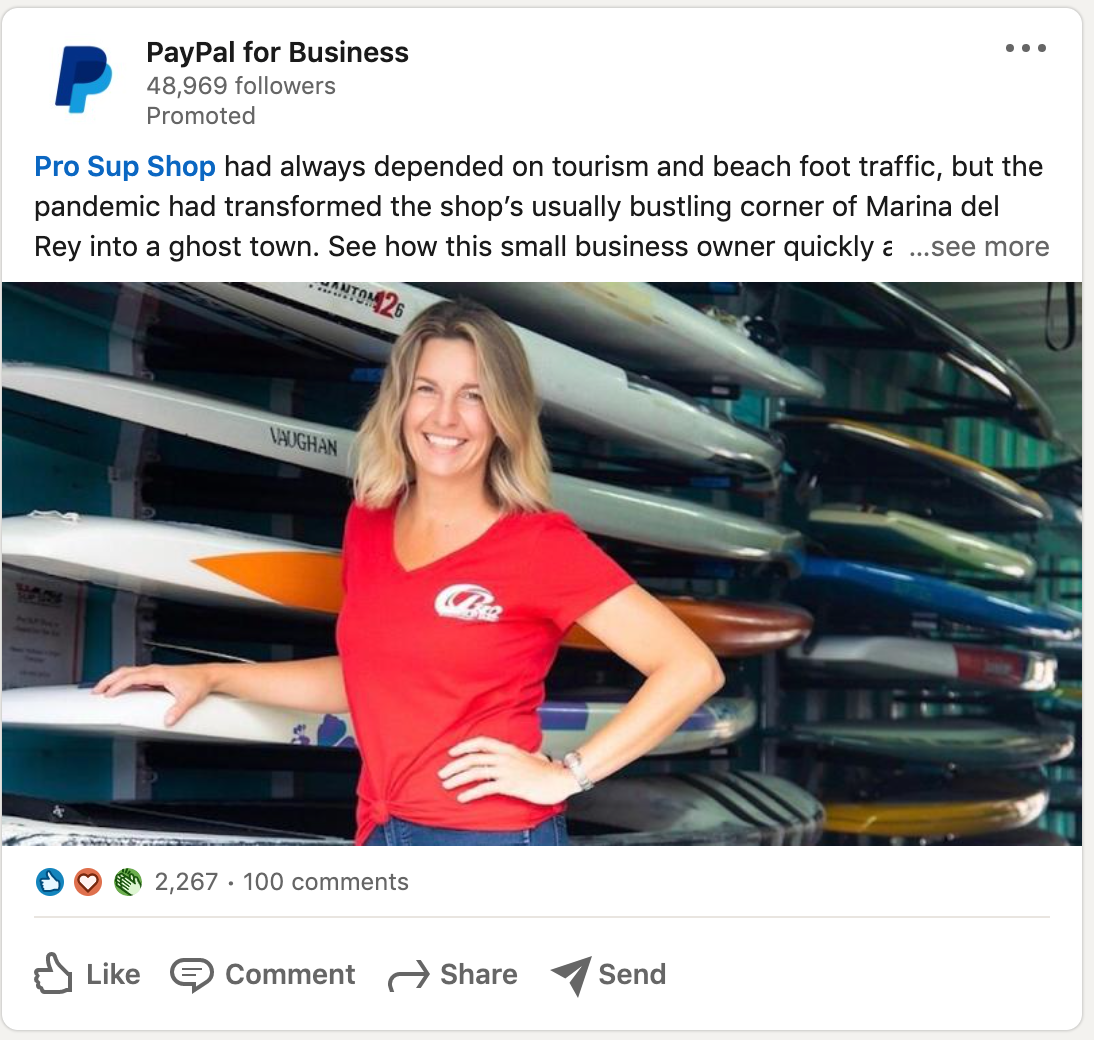
Notice the eye contact in the photo as well as the relatability of the case study in this PayPal ad.
This is an example of a case study ad. The image is a smiling face making eye contact with the camera, and a tourism business owner hurt by the pandemic would be very curious to learn how this customer solved her problem.
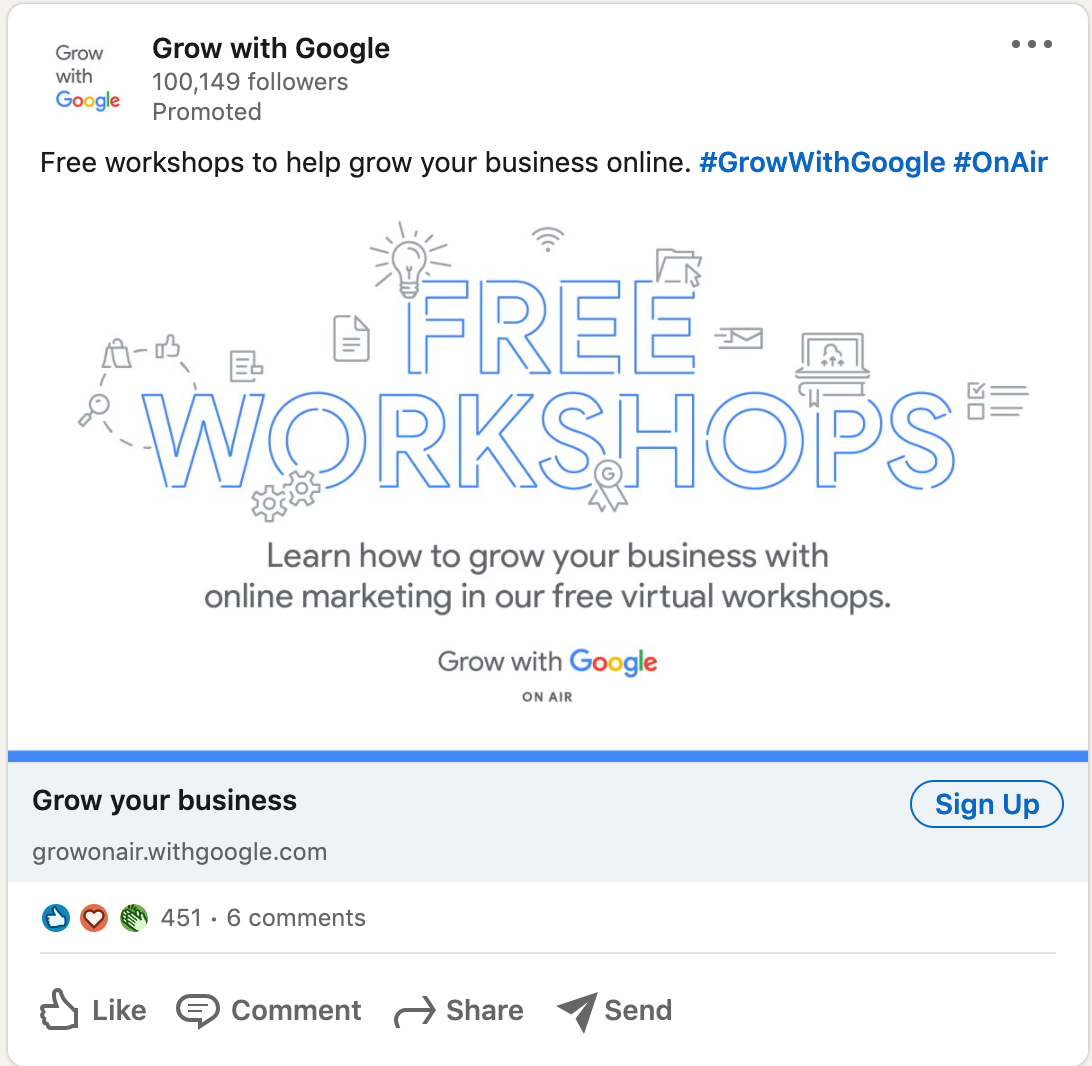
Grow with Google — Once you’ve achieved name recognition like Google, you can break a few rules.
This ad breaks a few rules. The image doesn’t include a person, and it isn’t high contrast or easy to read at small sizes. However, Google has tremendous name recognition and respect in the industry, making its free workshops very high value, so this ad doesn’t need to work very hard.
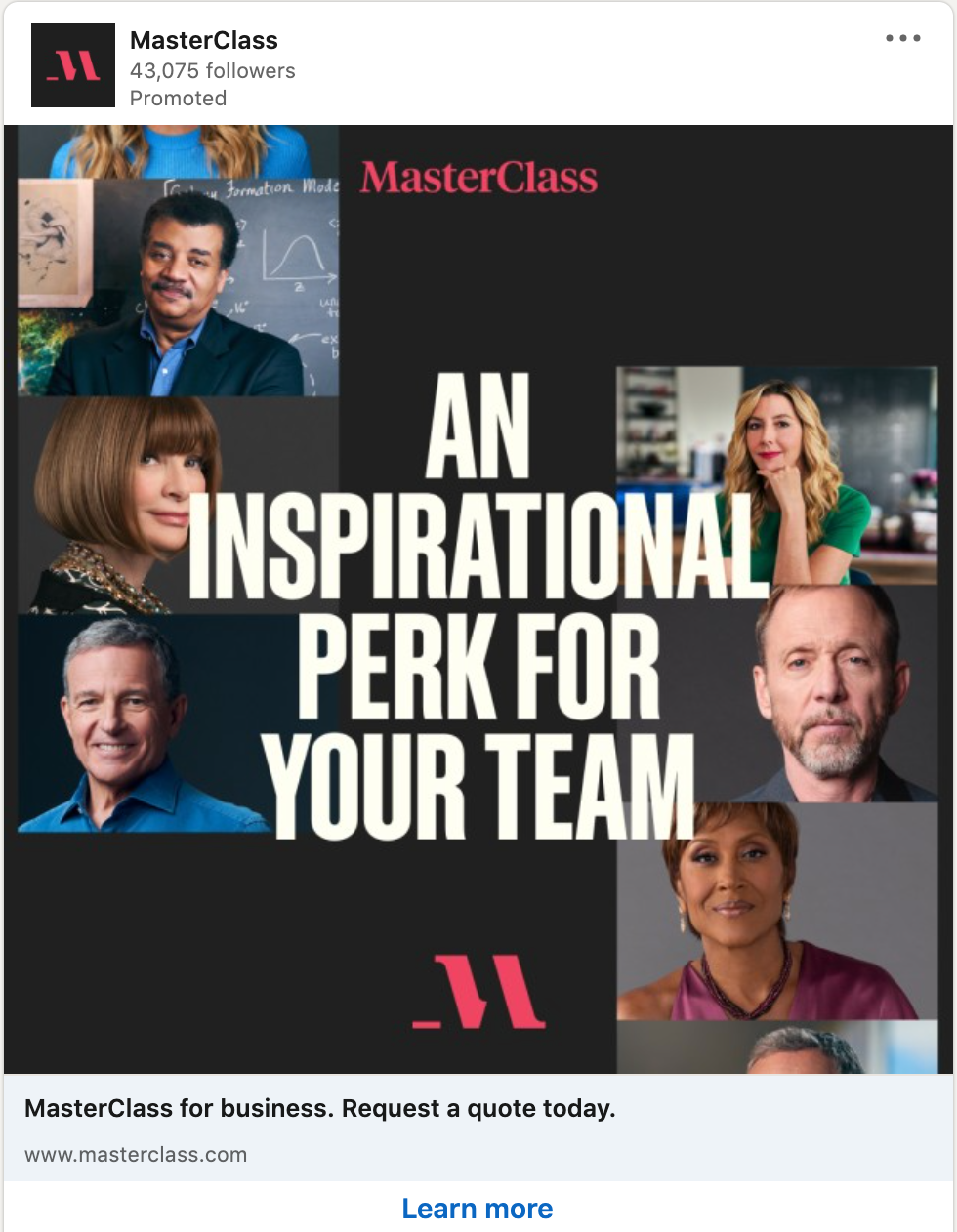
Eye contact and simplicity drive this MasterClass ad’s effectiveness.
MasterClass kept this ad simple, with no explanatory text at all. The image makes eye contact from several points, and the brief, easy-to-read text in the image (paired with a well-known brand) does all the work.

This inbox message, though brief and focused, could have been more personalized.
Here’s an example of an inbox message. This ad could have made better use of LinkedIn’s personalization features by using the recipient’s first name and specifying “your peers in the _____ industry,” but it’s brief and conversational and includes a clear call to action.

This University of Missouri System ad is a better example of personalization.
This dynamic ad greets the reader by name and includes their profile picture, which is great personalization. “Relevant opportunities” is a bit unclear — relevant to what? — but the call to action is simple and low risk. Ads that only ask for a follow don’t need to be as compelling as those that require a bigger investment of time, money, or personal information.
Move toward your goals
Now that you know how to create a LinkedIn ads account, set a budget, choose a target audience, and create effective ads, think about how you can use this marketing channel effectively to meet your business goals.
You can even use what you’ve learned to create a series of ads that move you toward multiple goals across different target audiences.
All you need to do to get started is decide whether you want to improve your brand awareness, increase your email list or LinkedIn following, or drive traffic to a webinar, landing page, free trial, or sales offer.
Digital & Social Articles on Business 2 Community
(72)
Report Post